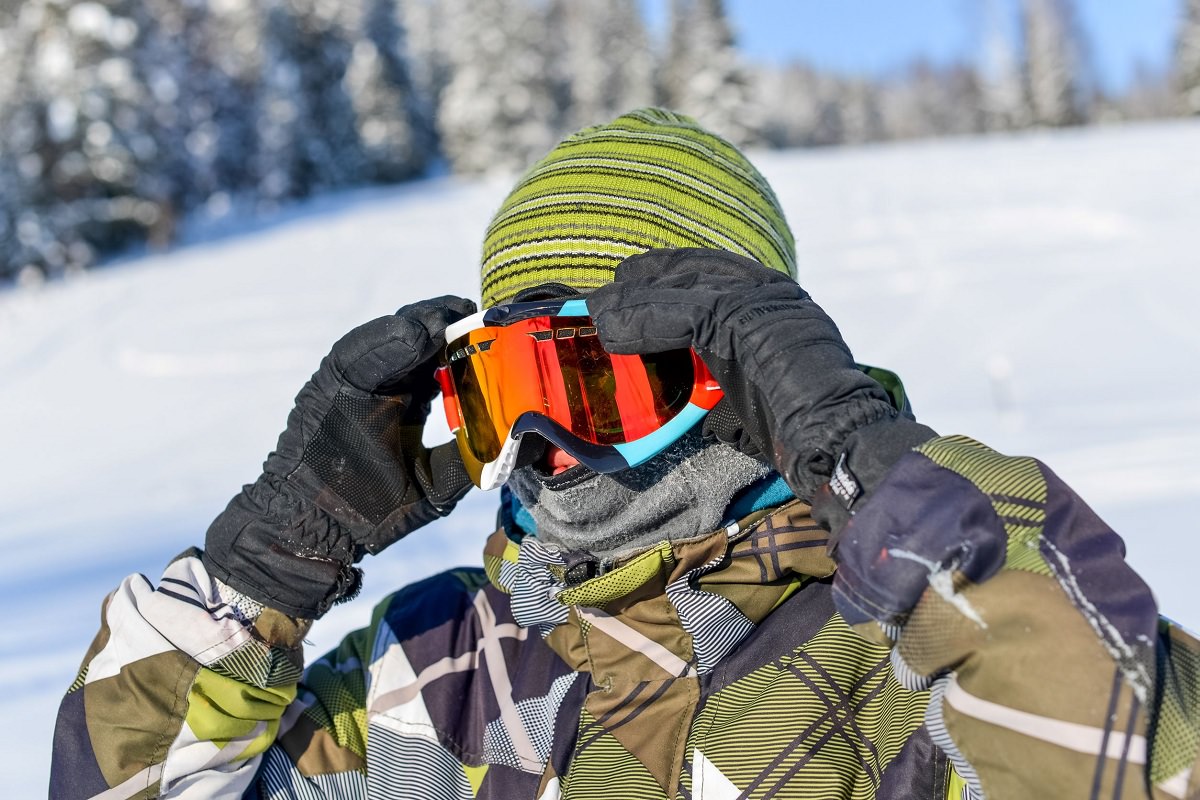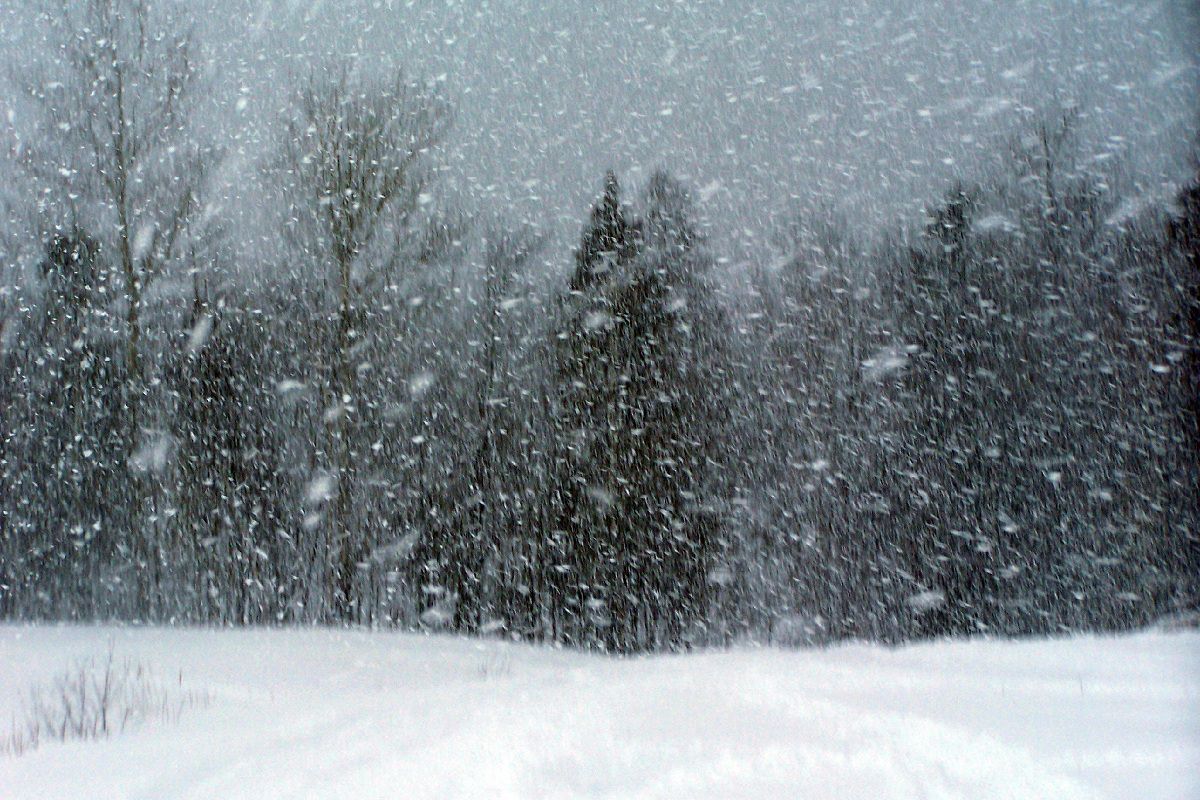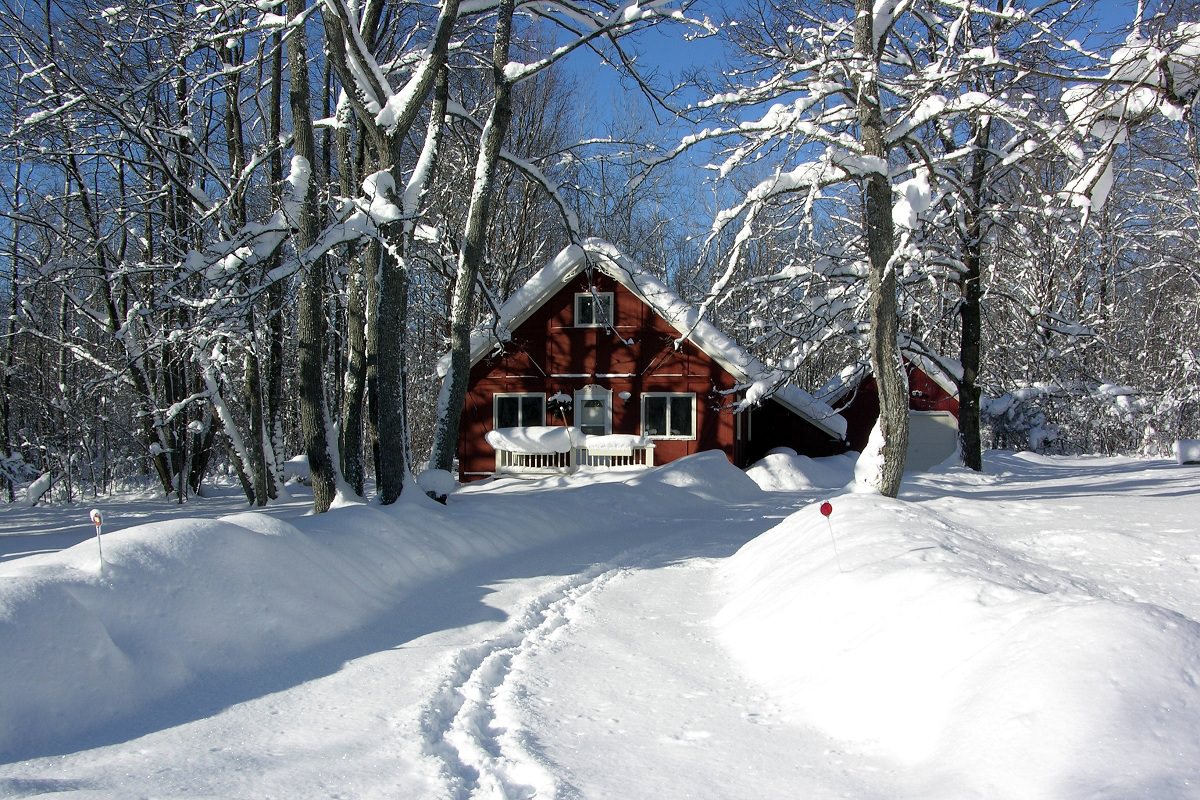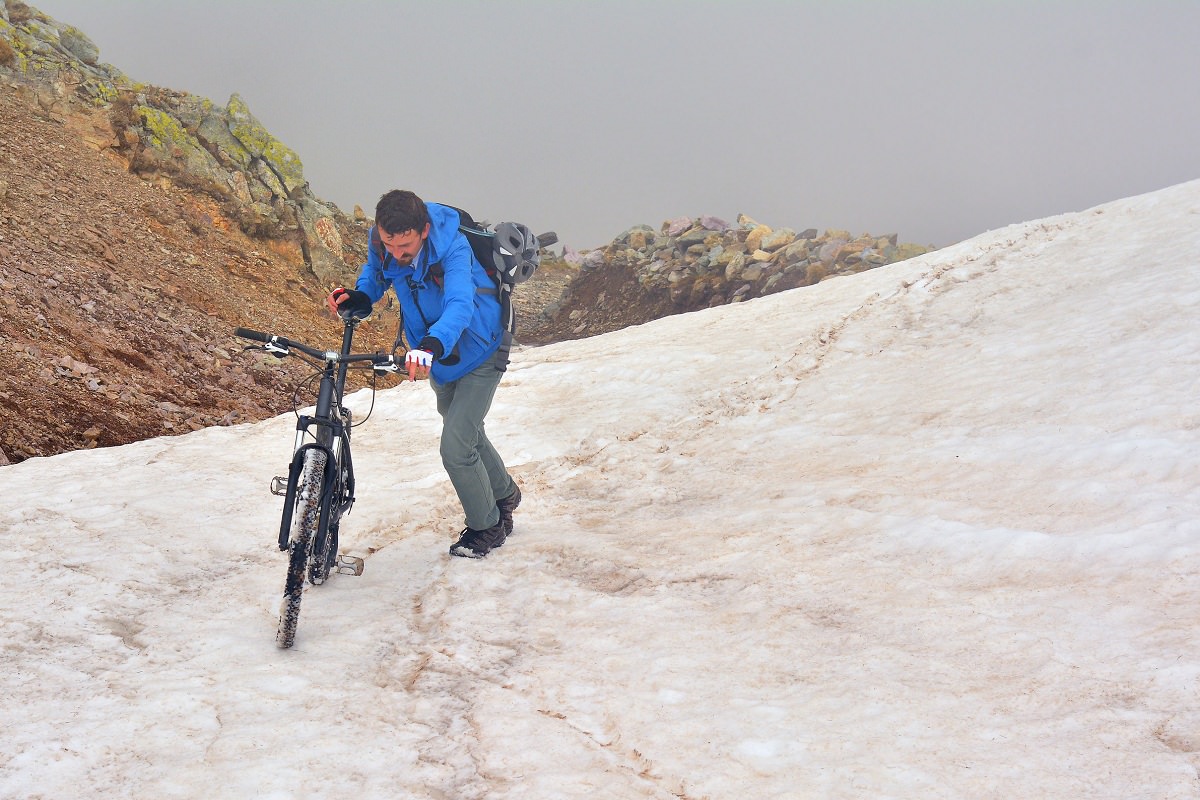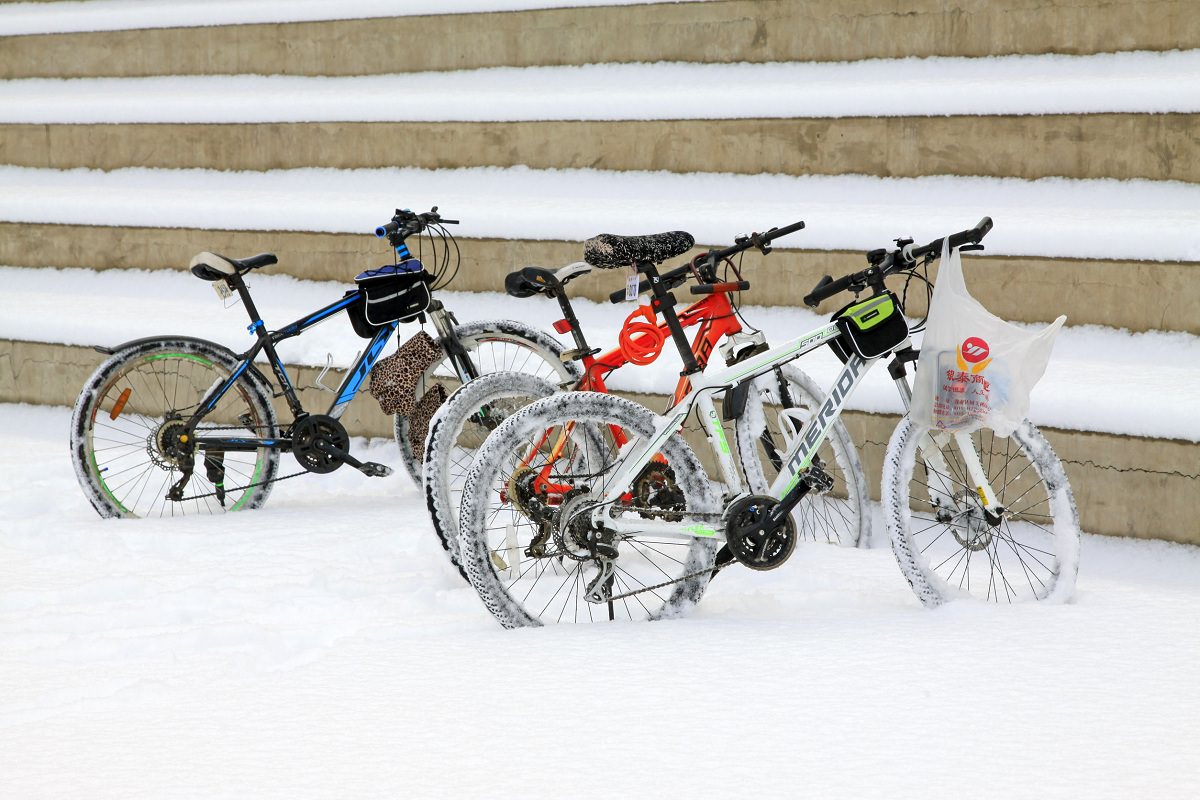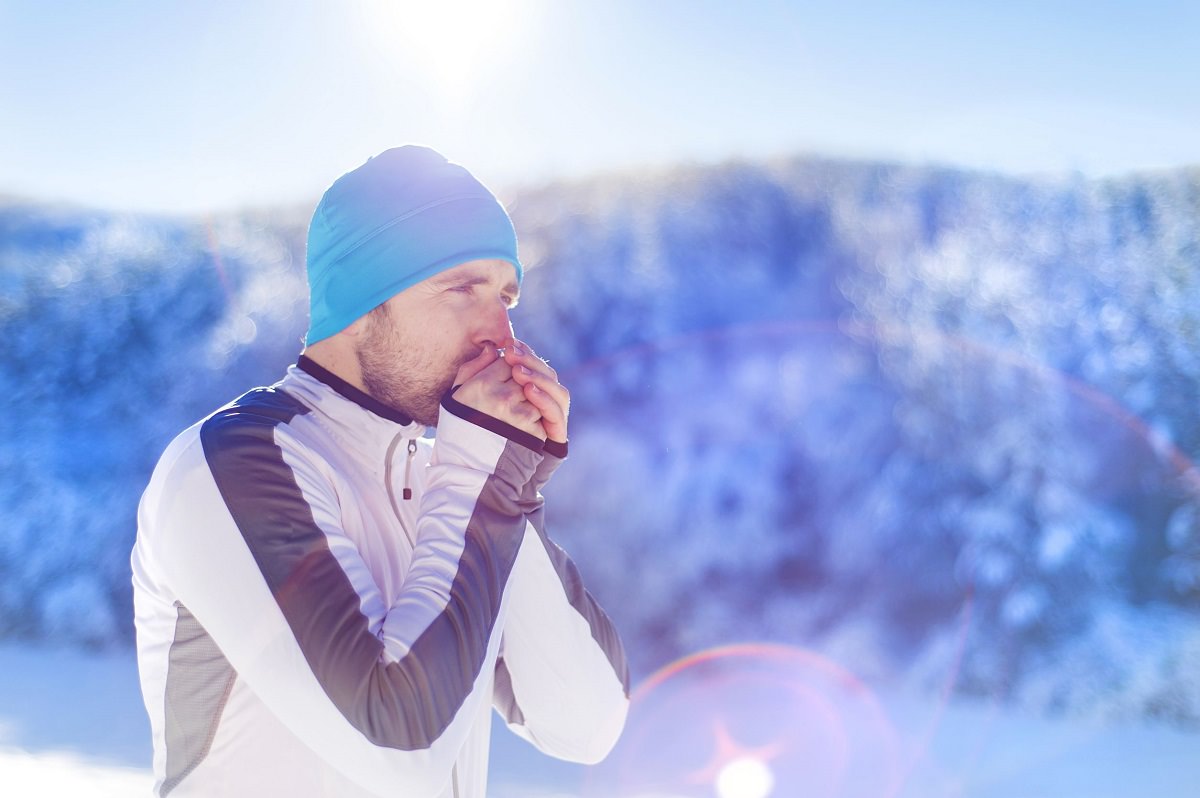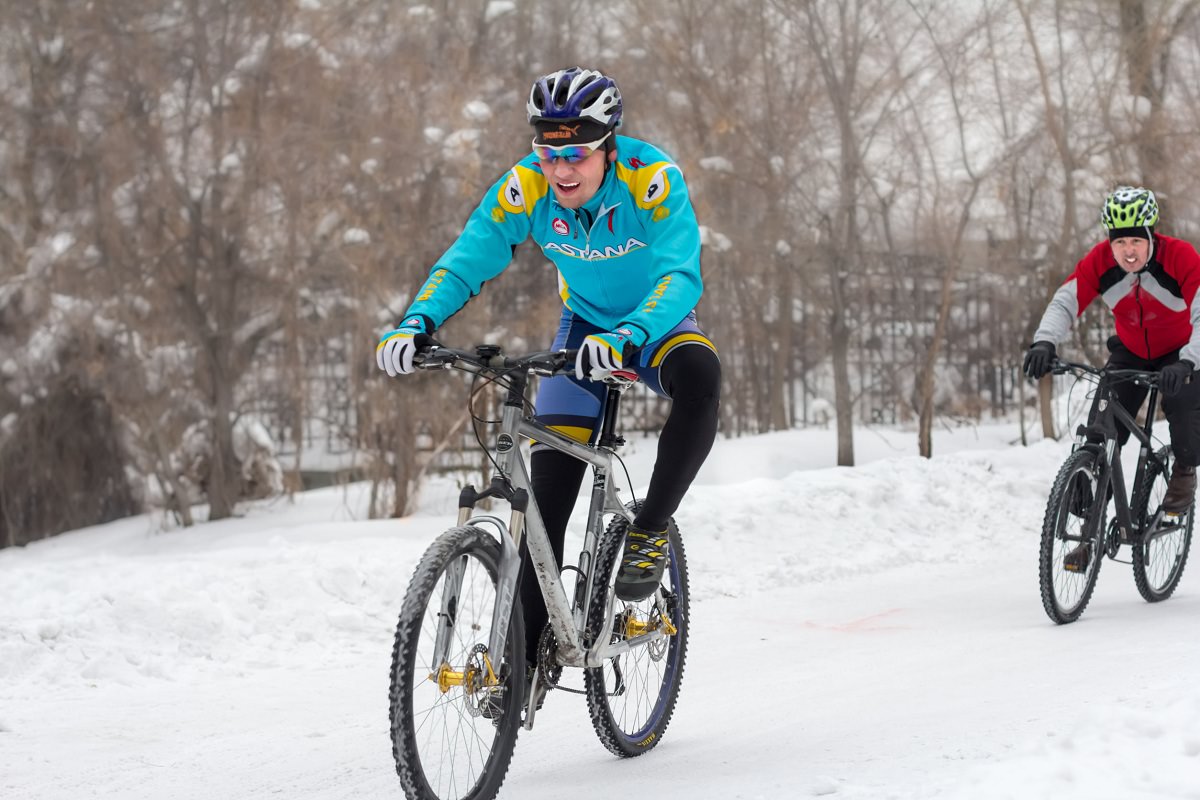Each climate requires different clothes. Don’t you agree? Being somewhat more stubborn than others, it took me two years to figure out combinations that worked well in all conditions. With an aim toward shortening the learning curve, I present the following discussions on clothing options.
Now, just because you don’t see it here doesn’t mean it won’t work. The contributors to this site can only go by their conditions and needs. Even under the same conditions, different riders have different needs. So be sure you apply a little independent thought before you blindly take advice written here.
Different Climates For Icebiking
There are several different climate types into which we will divide the world for icebike clothing. Your area will be predominantly one of the other of these, but it is likely to fall into each type for parts of the year.
1. Cold wet
Maritime areas, Oregon, Washington, Scotland, Maine, etc. Lots of rain, the potential for lots of heavy snow, and periods of quickly forming Ice.
2. Cool dry
Not really icebiking areas, but occasional Ice, Snow, and not a lot of rain. Mostly interior areas, Deserts, and prairie areas. Can have wind as a constant companion. Texas, New Mexico, and other high planes areas.
3. Cold dry
Very Cold areas, dry powder snow, windy. Canadian prairies, Interior Alaska, Greenland, Interior Norway, Finland.
4. Warm
Sorry, we don’t cover that here…
Each of these areas requires a different approach to dressing and how you dress depends on what you plan to do. The commuter may employ different strategies than someone going out to ride for several hours on a Saturday.
Dressing Strategy
Depending on the duration of the ride, several different strategies of dress can be used.
1. Layering
Layering is an outdoor clothing strategy that is probably already familiar to you, using layers of clothing that can be added and subtracted as the temperature and your activity change.
You might start with a warm-wicking garment close to the skin, a warmth pile above that, and a windproof outer layer. As you start on a winter ride, the temperature may be cold, and you will feel fine. As you heat up, or the day warms up you may want to remove a layer to keep from overheating.
You might want to add layers too, so carrying compact extra-layer garments is wise. This may come in handy when you stop to eat or rest and find that you are chilling. It is important to add clothing or subtract it before you get too cold or too hot.
You will find that you can control heat loss quite well by removing or adding headgear as your head is a very good radiator of heat.
Want to know the right method? Read our guide to understand how to layer winter cycling clothes!
Why Layering Doesn’t Always Work
The problem with layering in winter cycling is that it just doesn’t work very well. Many cyclists on the icebike mailing list report that they just don’t use the layering method at all. Here are some reasons:
- Cyclists are loath to stop and change layers because it is often the under layers that must be changed, seldom the top layer. If you are getting too warm, you will still want your windproof layer (the top layer), so what you have to do is remove that, then remove one of the under layers, find someplace to stash it, then get back on the bike and get moving before you get too cold. This is easy for a hiker, or cross-country skier, they can usually just add or subtract the outer layer, but a cyclist moving at 15 to 20mph can’t spare the wind shell.
- Then there is the problem of storing the removed layer. Unless you have a backpack or panniers this is a hassle. Of course, we aren’t even mentioning the problems involved in undressing and redressing in public or in a howling wind.
- Cyclists generate a lot of sweat. By the time you realize you are too hot, you are already wet. (A wicking underlayer helps a lot. See below). If you don’t remove the wet garment, you will chill yourself more than you think as the upper layers are removed. Cyclists can regulate temperature by level of effort. Too cold? Work harder! Overheating? Drop 2mph for the next mile and it makes a big difference, almost immediately. Winter commuters learn to dress for the temperature. They will start slightly underdressed, and therefore feeling a little cold. In a couple of miles, they are warmed up and cranking along.
- Once underway, most winter commuters will regulate temperature by work level rather than stop and change. Long-range commuters (an hour or more en route) report more frequent use of layering. Rain gear is the exception. Most icebikers will stop and don rain gear if it starts to rain en route.
- Recreational riders tend to be out longer and have stops planned, to eat, chat, or whatever. In these cases, where major changes of activity are planned, the layering principle comes on strong. Unlike commuters, trail riders can not plan on ducking into a store to warm up and must be prepared for breakdowns and changes in the weather.
2. Learning to Read The Weather
I’m not about to suggest you enroll in a meteorology class, but there is a great deal to be said for just paying attention to what works for you. If one ride is too cold, learn to think of what you wore as something that needs the assistance of another layer. This almost implies that you will make a few mistakes along the way, and over-dress or under-dress a few times till you get it all figured out.
Get in the habit of noticing if you are comfortable. Often I find myself riding along in some wicked cold weather saying to myself (yes, I do talk to myself and the bike too) “This is alright – This feels great”. I make a note of the temperature and what combinations of clothing I am wearing and store it away.
I get so I can just read the thermometer and know instinctively what to wear. I don’t often get surprised by poor decisions anymore. If you are new to winter cycling, it might take a year to figure out the right combinations of layers and fabrics.
Don’t be too stubborn to backtrack a mile or two to get an extra layer. It means the difference between an enjoyable outing and a discouraging ride.
I would like to recommend something as simple as a thermometer. These things are the greatest – you get up in the morning and look at the temperature and think “-12 C – ok, that means I only need my polypro undershirt and my polar fleece jacket, but I need the balaclava and the polypro layer on the bottom too”.
The nice thing about cycling is that you don’t have to adjust for varying wind-chill – once you’re cycling the wind chill is there even on a calm day. All you need to know is the precipitation situation and the temperature – one glance out my window and I know it all. The radio stations, TV, Internet, etc. give temperatures that vary by +-2 C (about +-4 F) over my thermometer – the effect of different locations within and around the city and/or lags in reporting temperature changes. So my thermometer is much better.
3. Wicking fabrics
One of the great boons to winter cycling, especially in freezing temperatures, is the advent of wicking fabric. Sold under various trade names (Capilene, Thermax, etc) these are usually a blend of polyester and perhaps up to 10 percent lycra thrown in for fit.
With these fabrics, it is not unusual to go out for a fast ride on a very cold day and have your outer layer be wet (not from rain) but the layer next to your skin be quite dry. The polyester fabric wicks the moisture to the outer layers where it condenses. The important thing is that you are warm and dry.
The North Face, Patagonia, and DuoFold are all manufacturers of “poly” fabrics.
Figuring Fabrics Of Winter Cycling Clothes
Selecting winter cycling clothes is hard enough with the need to be warm but not too warm, tight enough not to flap in the breeze but not binding, and water wicking but not water absorbent.
The task is made worse by the never-ending selection of fabrics with magic bullet names, mountains of hype and advertising claims, and expensive price tags. How can the average cyclist have time to determine what’s true and what’s hype? Which manufacturer’s claims and counterclaims should you believe?
Here we set out to gather all of this information in one spot and attempt to explain the buzzwords.
1. Wicking fabrics – the base layer
You often hear that a wicking underlayer is important and an absorbent underlayer must be avoided.
So what’s the difference? Absorbent fabrics soak up water and hold onto it. Wicking fabrics transfer water somewhere else, without absorbing it. At least that’s the claim. All wicking fabrics rely on capillary action, often combined with water-repelling coatings of the fibers. Most are some form of polyester, the only major exception being polypropylene. Some are microfibers.
(Microfibers are not a fiber unto themselves. It is a technology developed to produce an ultra-fine fiber, and then weave it or knit it into a very high-quality fabric. DuPont introduced the first polyester Microfibers in 1989.)
Capillary action (wicking in the truest sense) will attract water from locations where it is abundant and transport it to areas where it is less abundant. When all parts of a garment are equally wet capillary action ceases. Normally water in a fabric tries to coat all parts of each fiber. This seems to be water’s task in life.
If the fibers of the fabric can be made water repellant, rather than have the water cling to each fiber, it will have nothing to hold it in place and will act like water on the hood of a waxed car, it will essentially try to bead up. If the structure of the fibers is such that it is conducive to wicking (long parallel strands) then capillary action will pull this water in all directions where a lesser density of water exists.
Most fabrics that are touted as having good wicking characteristics will cause a single drop of water to bead up when dropped onto the fabric. Try this on some Thermax or Capilene and the bead will sit there for some time – minutes in some cases. If the water drop hits a fabric surface that is not horizontal it might just bead up and roll right off.
On cotton, a single drop of water will instantly disappear into the fabric. Polypropylene does not wick very well but will absorb a drop of water quickly. Now you might think that this would indicate that the Thermax or Capilene would be a poor transporter of water since it tends to repel water. You might think cotton and Polypropylene would be good wicking fabrics.
The truth is that capillary action is a weak force, and if the fabric is to wick, it must have no affinity for the water. Cotton has a great affinity for water. It soaks up water quickly – and holds on to it, keeping it near your skin.
It seems likely that department store personnel will take a very dim view of your dropping water on garments on the shelf, so do these tests at home and be prepared before you shop.
Wicking in the winter
Wicking fabrics tend to move perspiration away from the source (you) to any place dryer. It is not unusual to find the outer garment soaked and the inner one comparatively dry. This is because unless it is warm enough for evaporation to take place, the upper layer is as far as water transport can go before colder temperatures slow it down. This saturation will eventually work backward, building water closer and closer to your skin. When that happens, you are going to get cold as soon as you stop exercising.
2. Warmth fabrics – mid layer
If this page dealt with natural fabrics, high on the list would be wool. Still a good choice for cyclists, wool middle layers provide excellent thermal properties and keep you warm even when wet. However, you know wool.
The news these days is in the newer “fleece” fabrics. These fabrics are tightly woven meshes, usually of microfibers that provide air entrapment, wicking, and high insulation properties while retaining light weight.
Probably the best known is Polartec from Malden Mills, however, there are several others such as Synchilla fleece, Capilene fleece, etc. Some of these are made from recycled soda bottles which are melted and spun into polyester fibers.
These fleeces are far lower maintenance than wool, and they dry quicker and provide wicking so that moisture wicked up by your base layer is moved away from you. Fleece garments don’t shed water very well and usually require a shell of some sort.
The other “new” insulation fabric is Thinsulate, by the 3M company. New is in quotes because it has been around in one form or another since 1978, although new varieties are appearing regularly. Thinsulate is a blend of polyester and olefin (neither of those terms is all that specific, but it is hard to pry these secrets from big companies). Thinsulate is a microfiber material and can often be found in some of the same types of garments as fleeces. Some Thinsulate is recycled material.
The problem with warmth fabrics
I’m not aware of any issues with these newer fleece fabrics in winter use. After all that is precisely what they were designed for. They even work well when wet. The only problem is that they are not durable and need a shell to protect them, and they can pick up odors if not washed frequently.
3. Breathable fabrics – the outer layer
Breathability is the ability of a fabric to pass water vapor while blocking water. It does this usually by having micro-pores, holes too small to allow liquid water in, but large enough to allow water vapor out.
One would think that a molecule of water is the same regardless of its physical state – one oxygen atom bound to two hydrogen atoms. True enough, but in the liquid state there is the stickiness of the molecules themselves, (they tend to clump together), and surface tension. These two forces (maybe they are the same force by different names) combine to prevent the passage of liquid water through the membrane. Apply a little soap to the outside of any microprobes fabric (thereby destroying the surface tension of liquid water) and your rain jacket passes water just like cotton.
These microporous fabrics (Gore-Tex being the prime example) work on a partial pressure differential between the sides of the fabric. It must be more moist and warm inside the jacket than it is outside the jacket or it will not pass water vapor in the preferred direction.
Also, any accumulated rain on the surface tends to block the holes preventing the breathing effect that we are counting on to carry away water vapor. However, it is a common misconception that as soon as you get the outside of your Gore-Tex cycling jacket wet all breathing ceases. This is not true, because your Gore-Tex is not wet, just the shell. The Gore-Tex is sandwiched under the shell, it is laminated to the base fabric, which is usually nylon and always treated with a water-repellant finish.
It is far too delicate to serve as an outside layer. It is also too delicate to serve as an inside layer, so it is usually protected by a sewn-in liner. (You can see the actual Gore-Tex by looking at the inside of the shell if you can find any place where there is no liner, such as at pit zips or shoulder vents.)
However, if your shell layer is saturated, even if the Gore-Tex is still breathing, the result may be the same. Its no use having breathable layers if the outer layers prevent all breathing when they become saturated.
Not all breathable fabrics are made this way. Some are coatings applied to a base fabric. (The difference between a coating and a laminate is largely a difference in the construction process).
Lowe Alpine and Unitika Industries manufacture a fabric called Triplepoint Ceramic which uses two coatings to achieve breathability. The first layer is the microporous water-repelling layer, and the second is a water-attracting non-porous layer. (The second layer is to the exterior of the garment.) A water-repellent finish is then added on top.
After a good soaking, your breathable fabric does stop breathing to an extent. Tests showed that all fabrics lose an element of breathability in wet conditions. The various configurations of Gore-Tex lost between 34 and 43% of their breathability, Helly-Tech’s decline was just short of 75%, but Lowe Alpine’s Triple Point Ceramic 1200, lost just 15% of its breathability. So don’t believe the naysayers who tell you that your breathable jacket stops breathing in the slightest rain.
As far as I can tell, all breathable but waterproof fabrics rely heavily on the water-repellant outer finish to prevent the microporous layers from getting plugged by water (as might happen in heavy rain) or grease, dirt, and oils.
You may be able to replenish this water-repellant layer as it ages by using spray on commercial products such as Nikwax or “Scotchgard Water Repellent for Outdoor Fabrics”. There have been raging debates on this subject on various bicycle mailing lists, but the key point to remember is that the fabric manufacturers themselves apply such a coating.
Only spray the outside surface and don’t rub or iron it in, the water repellency is needed only on the surface. In addition to waterproof fabrics, there are windproof fabrics for use in outer shells. These may be the heavier pack-cloth or Cordura type of fabric, or the newer micro-fleeces which incorporate a windproof layer.
The windproof micro-fleeces are some of the better fabrics for winter cycling (at below-freezing temperatures) because they are highly breathable, very warm, and light. These garments often weigh less than half as much as a conventional winter garment and are less restrictive to movement.
And, since they are highly breathable, much more so than any of the rain gear-oriented fabrics, you will not get as clammy wearing them when working hard. These garments typically can serve as a mid-layer or an outer layer and as such are very versatile.
Windstopper is the trademark of Gore for their microfleece with a windproof layer. This fabric is used by Pearl Izumi, The North Face, and many others to make windproof garments. These fabrics just arrived on the market in 96 and are not yet well known or proven, but several icebikers report good results with WindBlocker Fleece.
Breathability in the winter
None of the manufacturers are too specific about their claims of breathability in very cold weather. There is some speculation that water vapor dutifully vented through the microporous layer will become trapped in that layer or the shell layer as it freezes upon contact with the cold.
You may have seen evidence of this while icebiking. You may notice a very fine frost forming on your jacket. If you take off the jacket you can sometimes shake this frost off. For this reason, and for the fact that when it is that cold you don’t need to worry about rain, many cyclists switch to some other outer layer when it gets really cold.
The windproof fleeces are designed for the cold, so presumably, they will operate better in this environment than the waterproof materials.
Understanding Different Fabrics
Definitions (more than you wanted to know):
- Nylon: Polyamide in which less than 85% of the amide linkages are directly attached to two aromatic rings (Huh?)
- Olefin: At least 85% ethylene, propylene, or other olefin units
- Polyester: At least 85% ester of a substituted aromatic carboxylic acid including but not restricted to substituted terephthalate units and para-substituted hydroxybenzoate units (Ah, Ok)
- Rayon: Regenerated cellulose with less than 15% chemically combined substituents (Artificial Fibers – see below)
- Spandex: Elastomer of at least 85% of a segmented polyurethane
- Synthetic: Man-made fibers are further subdivided into two broad classes based on the production process used to obtain them. “Synthetic” man-made fibers are produced by polymerization of organic monomers (an organic molecule is a chemical that contains carbon and was usually, (but not always) derived originally from living matter).In general, these monomers are derived from petroleum distillates and the process involves the linking together of the monomers by chemical means. For example, the organic monomer ethylene is connected in a continuous chain of repeating ethylene monomers to form polyethylene which is extruded through a spinneret to form a polyethylene fiber.
- Artificial: The second class of man-made fibers is the “artificial” man-made fibers. These fibers are produced by transforming natural organic polymer. In other words, these products typically exist as polymers in the natural state such as cellulose in wood, and are broken down and reassembled in artificial fibers. Since they had a pre-existence as polymers, their manufacturing process is distinctly different.
Properties of various fabrics
| Brand Name | Manufacturer | Construction | Wicking | Layer | Design Use | Comments |
|---|---|---|---|---|---|---|
| Polartec | Malden Mills | Polyester Fleece | Yes | mid/outer | Warmth | Several Varieties |
| Xalt | Burlington | Two layer Gore-Tex clone | No | outer | Breathing | New Fabric |
| Gore-Tex | Gore | Two/Three Layer | No | outer | Breathing | |
| Activent | Gore | Not air permeable yet, Breathable* | No | outer | Breathing | |
| DryLine Milliken | Two Layer Polester/Nylon | Yes | base | warmth | Base Layer | |
| Akwatek Comfort Technologies | Polyester | Yes | base | warmth | Retail Source | |
| Akwadyne | Comfort Technologies | Nylon terry | Yes | base | warmth | Licensee |
| Thermastat | DuPont | Dacron (hollow core) | Yes | base | warmth | Used by Duofold |
| Versatech | Burlington Mills | Windproof Water resist | No | outer | Breathing | Cheaper Activent |
| Therma F.I.T. | Nike | Polyester Fleece | Yes | mid/outer | Warmth | thinner than most |
| Windstopper | Gore | Windproof Micro Fleece, Breathable* | Not Necessarily | mid/outer | Warmth, Breathable, Wind Proof | |
| Pile & Pertex | Buffalo | Windproof Micro Fleece, Breathable* | Yes | mid/outer | Warmth, Breathable, Wind Proof | Special Review |
*Breathable here refers to water vapor transiting the fabric.
What to Avoid While Dressing For Winter
As a habitual icbiker, here are some things
- The general advice is to avoid cotton next to the skin. Some folks get downright adamant about this. Others just avoid it on long rides. The problem is that cotton soaks up perspiration and just hangs on to it, keeping it right on your skin. The minute you slow down or stop working you get very cold very quickly.
- Avoid over-dressing. Start out a little cold. If you are worried about freezing take along another garment, but don’t go out overdressed.
- Avoid the idea that if it wasn’t made for cycling it isn’t any good. In fact, you will find relatively few “made for cycling” products that work well in winter. There are just now beginning to come available cycling tights that are warm enough or gloves that keep your hands warm when they are in the same position for hours. Often ski equipment works well.
- Clipless pedals and shoes generally don’t cut it in really cold winters. Even if they did not get packed with snow and work poorly, the cleats are generally bolted to a steel plate directly under your foot. This sucks the heat right out through the cleat and freezes the sole of your foot in no time. Clips and straps work better. A lightweight winter boot or hiking boot keeps you warm. If they aren’t “bikey” enough for you, feel free to cover them with garish spray paint.
Understanding Systemic Hyperthermia
| Core Temp | Degree of Hypothermia | Signs and Symptoms | Cardiorespiratory Response | Level of Consciousness |
|---|---|---|---|---|
| 95 F | Mild | Shivering, Foot Stamping | Withdrawn | |
| 90 F | Mild | Loss of Coordination | Confused | |
| 85 F | Moderate | Lethargy | Slow Pulse | Sleepy |
| 80 F | Severe | Coma | Weak Pulse, Arrthymthmias, Slow respirations | Irrational |
| 78 F | Severe | Apparent Death | Ventricular Fibrillation, Cardiac Arrest | Unconscious |
How To Dress For Winter Cycling- My Advice
Knowing how much is enough is the key. Given the differences in personal perceptions of cold, I am reluctant to make specific recommendations as to what combinations to wear at various temperatures. In the fall, I find I can wear shorts in colder temperatures than I would in the spring. Hanging on to summer, I guess. But I have found a couple of hints along the way that keep me from making big clothing mistakes.
First, if you step outside and are cold, right away, (not on the face, but on the torso, under your shirt), you are dressed too light and you will probably never warm up. Go back in and add a layer.
If you are mildly chilly as you finally get moving, you will warm up soon. Don’t push too hard at first. Warm up for the first mile or two before you start cranking. If you warm up too fast in the first mile, you can plan on being way too warm a couple of miles down the road. Not to mention drenched in sweat.
If you are warm standing around getting ready, you will be drenched after even a short ride. If you are on a day-long outing, or going in a wilderness area be careful about just how sweaty you allow yourself to get. If you are wringing wet and you break a chain or get a flat, you could be in serious trouble and have unpleasant chills by the time you get it fixed or walk back. Hypothermia can sneak up on you.
If you find yourself starting to shiver soon after you get off the bike, you had better rethink your plans. It may be time to turn back. If you have the energy to continue riding, then do so immediately. Don’t work so hard that you start sweating heavily again, just raise your temperature and keep it at a comfortable level. If it appears that you can’t go on, stop and build some sort of shelter or dig a hole in the snow before you run totally out of gas.
Lastly, but most importantly, don’t take anything you’ve seen here on this site as a recommendation to go roaring off into some vast frozen wilderness on your bicycle unless you know what you are doing, or you are going with someone who does.
If something breaks:
- You can be in trouble even in Upstate New York.
- You can be in serious trouble in Northern Minnesota.
- You can be seriously dead in Central Alaska.
It seldom happens to icebikers, because they are too smart, but every year several snowmobilers and skiers are lost in Alaska, the Yukon, and other frosty places. The North does not suffer fools gladly. For your first winter of cycling, in the backcountry, go with cycling buddies. If commuting, you will probably not have any problems as most commuting routes are well traveled, but avoid very rural routes till you are sure of the weather and your ability to handle it.
Recap
Ok, so you’re ready to go. But you need to be aware of when you are ready to stop. Unfortunately, this is not always easy to know. Biology conspires against you. One of the insidious things about cold weather is hypothermia.
It’s not that it sneaks up on you. You will know you are getting cold. You will be shivering. The next thing you know you have your hat off, your jacket unzipped and you think you are too warm. You don’t seem to care about the cold anymore.
The bad part is by that time you may be too far gone to recognize the problem. You need to pay attention to the EARLY warning signs, those in the first two rows below. And watch your riding partners too.
Also Read


